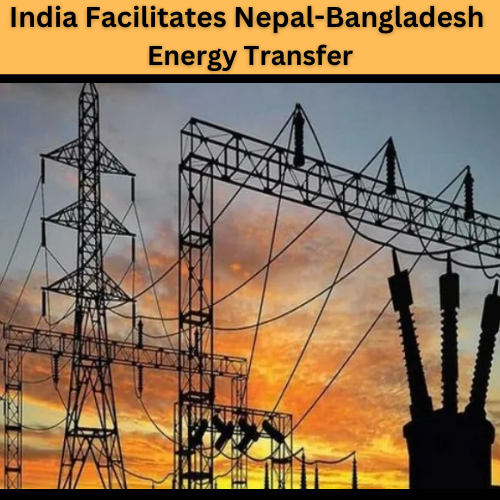Introduction
When nations come together for a common purpose, magic happens—and in this case, that magic is electricity! Nepal, India, and Bangladesh are teaming up to create a seamless energy exchange, proving that collaboration truly lights up the world. With Nepal’s hydropower surplus, India’s grid connectivity, and Bangladesh’s growing energy needs, this partnership is a triple win for South Asia. Let’s dive into the details of this electrifying collaboration!

Nepal’s Role: Turning Water into Power
Nepal is known for its breathtaking mountains and roaring rivers, but here’s something else to add to its brag list—hydropower! The country generates a significant amount of renewable energy from its rivers, with many projects producing more electricity than Nepal can use. What’s a nation to do with all that surplus? Export it, of course!
For Nepal, exporting energy is not just about making money; it’s about positioning itself as a key player in South Asia’s energy market. By selling its clean, green energy to Bangladesh, Nepal not only boosts its economy but also strengthens its ties with neighboring countries. It’s a win-win scenario, with rivers flowing in more ways than one!
Bangladesh’s Role: A Nation Hungry for Power
Bangladesh is buzzing with development. From growing industries to urban expansions, the country’s energy needs are soaring. But let’s not forget—Bangladesh is also striving to meet its climate goals by incorporating more renewable energy sources. That’s where Nepal steps in, offering a clean energy solution to power Bangladesh’s growth.
For Bangladesh, this deal is a game-changer. It gets access to Nepal’s eco-friendly electricity without having to build expensive infrastructure for its own power plants. This energy partnership aligns with Bangladesh’s vision of sustainable development, proving that growth and environmental care can go hand-in-hand.
India’s Role as a Facilitator
Now, let’s talk about the star of this show—India! With its massive power grid infrastructure, India acts as the bridge between Nepal and Bangladesh. Thanks to its strategic location and well-established electricity networks, India plays a crucial role in making this energy transfer a reality.
But India isn’t just a middleman; it’s a facilitator of regional harmony. By supporting this initiative, India demonstrates the power of partnerships in solving shared challenges. The country is showing that being a good neighbor doesn’t just mean sharing borders—it means sharing resources, too!
Technical Aspects: How Does the Energy Flow?
Here’s the nerdy but fascinating part: how does electricity actually travel from Nepal to Bangladesh? It’s all about grid connectivity. Nepal feeds its surplus power into India’s high-capacity transmission network, which then channels it across the border to Bangladesh. Think of it like a relay race, but with electricity instead of batons!
This process requires a lot of technical wizardry, from synchronizing power systems to managing voltage levels. But with agreements in place and modern technology at their disposal, the three countries are making it work. It’s a feat of engineering that’s as impressive as it is essential.
Benefits of the Initiative
This energy exchange isn’t just about keeping the lights on—it’s about creating brighter futures for everyone involved. Nepal gains a new revenue stream, turning its natural resources into economic prosperity. For Bangladesh, the deal ensures a steady supply of clean energy to fuel its ambitions.
And let’s not forget the bigger picture: by working together, these nations are setting an example for regional cooperation. Energy isn’t just a commodity; it’s a connector, bringing countries closer in ways that go beyond kilowatts and grids.
Challenges and Solutions
No grand initiative is without its hiccups, and this one is no different. From negotiating tariffs to ensuring smooth transmission, there’s a lot to iron out. And let’s not even get started on the technical challenges—maintaining grid stability across three countries is no small feat.
But here’s the good news: these challenges are being tackled head-on. With transparent agreements and strong political will, the countries are proving that obstacles are just opportunities in disguise. It’s all about teamwork, innovation, and a shared commitment to making this work.
Regional Implications: Lighting Up South Asia
This partnership isn’t just a transaction; it’s a template for what’s possible when nations collaborate. By showing that energy can be shared across borders, Nepal, India, and Bangladesh are paving the way for a more integrated South Asia.
Imagine a future where every country in the region contributes to a shared energy pool, leveraging their unique strengths to benefit everyone. It’s a vision that’s as inspiring as it is achievable, thanks to initiatives like this one.
Future Prospects
This is just the beginning! As Nepal continues to expand its hydropower capacity and Bangladesh’s energy needs grow, the potential for larger energy exchanges is huge. There’s even talk of including more countries in the network, creating a South Asian energy grid that’s as interconnected as the region’s rivers.
With renewable energy becoming a global priority, this initiative could serve as a model for other regions. Who knows? Today’s small step could lead to tomorrow’s giant leap in global energy cooperation.
Conclusion
In a world that often feels divided, this energy partnership is a shining example of what’s possible when countries work together. Nepal, India, and Bangladesh are proving that shared resources lead to shared success—and in the process, they’re building a brighter, more sustainable future for everyone.
Let’s celebrate this electrifying collaboration and hope for many more to come. After all, the world is always better when we light it up together! 🌟
